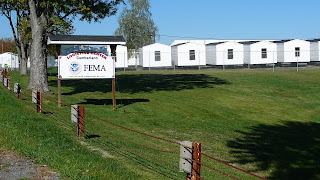Penn State does love their football. And Halloween. This weekend was the perfect storm: Saturday night game, against Michigan, on Halloween. Even by Friday afternoon it was difficult to drive out on the strip and hard to walk downtown. Amazing how much shopping was going on with the football crowd - you'd think they didn't have shopping at home. But I'm sure it was partly nostalgia - to shop where you used to shop as a student, or eat where you used to eat, or to see what's new in town since you left.
Friday night was quite a treat as the students put on a wonderful show in the streets with their costumes. Costuming here is very big - some very creative. I wish my camera worked better in low light so I could have gotten some pictures. We had a guy in a shark costume wearing a Joe Patterno mask, a very nice home-made dinosaur outfit, a Captain America unitard, it was endless as folks just swarmed downtown seeing and being seen. Oh, and drinking. There was some disappointment here this year when Penn State fell from number 1 to number 3 party school in the nation.

 Ann's co-worker Renee and her husband Dave have been going to the games for years, and invited us to tailgate with them at their camper in the lot across from the stadium. So at 4:30 we jumped on our bikes and rode the 2 miles across campus to the stadium to their encampment. Traffic by that point was surprisingly minimal. Everyone who was going to find parking had already found parking somewhere long before then. Given the heavy pedestrian traffic across campus, many must have parked far, far away. It seemed barely 50 degrees out, but the line for ice cream at the Creamery snaked around the block. A few blocks from the stadium, all roads were closed to cars and we were joined in the street by the happy inbound crowd - a few weaving a bit. For them the drinking had started long before - probably the night before.
Ann's co-worker Renee and her husband Dave have been going to the games for years, and invited us to tailgate with them at their camper in the lot across from the stadium. So at 4:30 we jumped on our bikes and rode the 2 miles across campus to the stadium to their encampment. Traffic by that point was surprisingly minimal. Everyone who was going to find parking had already found parking somewhere long before then. Given the heavy pedestrian traffic across campus, many must have parked far, far away. It seemed barely 50 degrees out, but the line for ice cream at the Creamery snaked around the block. A few blocks from the stadium, all roads were closed to cars and we were joined in the street by the happy inbound crowd - a few weaving a bit. For them the drinking had started long before - probably the night before. On game day, State College is the third largest city in Pennsylvania -108,000 fill the stadium in a town of 30,000. It is quite a site. Many folks have had their tailgating spot for years, and know their tailgating neighbors - although that is changing as ticket prices rise and more are sold to businesses to be distributed as perks to a different employee each game. Renee and Dave put on a wonderful spread, and even provided outdoor satellite TV so all could watch the pre-game. Family and friends came and went, visited and ate. The kids played in the motor home. The beef stew in the crock pot inside was heaven. We enjoyed the socializing and soaking up the pre-game atmosphere. A few brave souls from Michigan across the way in their full Maize and Blue regalia received only a little good natured ribbing and seemed to know the Penn Staters nearby well. I guess that's the Big Ten for you - rivalry and camaraderie. If you didn't go to one Big Ten school and your spouse another, it's likely your kid does.
On game day, State College is the third largest city in Pennsylvania -108,000 fill the stadium in a town of 30,000. It is quite a site. Many folks have had their tailgating spot for years, and know their tailgating neighbors - although that is changing as ticket prices rise and more are sold to businesses to be distributed as perks to a different employee each game. Renee and Dave put on a wonderful spread, and even provided outdoor satellite TV so all could watch the pre-game. Family and friends came and went, visited and ate. The kids played in the motor home. The beef stew in the crock pot inside was heaven. We enjoyed the socializing and soaking up the pre-game atmosphere. A few brave souls from Michigan across the way in their full Maize and Blue regalia received only a little good natured ribbing and seemed to know the Penn Staters nearby well. I guess that's the Big Ten for you - rivalry and camaraderie. If you didn't go to one Big Ten school and your spouse another, it's likely your kid does.As game time approached and the temperatures dropped, the parkas and blankets came out, the stadium lights came on, and we bid farwell, stuffed our hot dish in the pannier, and rode our bikes west into the sunset against an ever thickening stream of humanity clad in Blue and White headed for the Game.















































